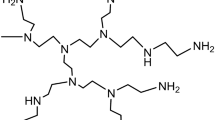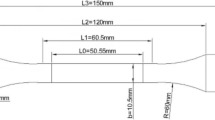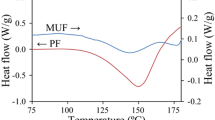Abstract
In this paper, the effect of blocked polyurethane prepolymer (BPUP) with four R values (the ratio of –NCO to –OH) and different blending proportions on the characteristics of melamine–urea–formaldehyde (MUF) resin were first investigated. The properties of the modified adhesive systems were examined by dynamic wettability and shear strength. The results indicated that the bonding performance and the wettability of high R value blending modification were superior to that of low R value case. In addition, the optimal bonding performance came from the MUF resin modified by 15% BPUP (R = 5) addition. Besides, the K value on wood substrates with different moisture contents (MC) was calculated by wetting model to interpret the wetting kinetics. The polymer blending adhesive has a potential capacity for making wood-based panels from high-moisture raw materials.






Similar content being viewed by others
References
Cai X, Riedl B, Wan H, Zhang SY, Wang XM (2010) A study on the curing and viscoelastic characteristics of melamine–urea–formaldehyde resin in the presence of aluminium silicate nanoclays. Compos A Appl Sci Manuf 41(5):604–611
Chen CM (1972) Measuring the wetting of wood surfaces by adhesives. Jpn Wood Res Soc J 18(9):451–456
Fahmina Z, Eram S (2012) Polyurethane. InTech, Croatia, pp 8–16
Halliday DR, Rensick R, Walker J (1997) Fundamental of physics. John Wiley and Sons Inc, New York
Lee DJ, You SH, Kim HD (1999) Synthesis and properties of thermotropic liquid crystalline polyurethane elastomers (II): effect of structure of chain extender containing imide unit. Korea Polym J 7(6):356–363
Liptáková E, Kúdela J (1994) Analysis of the wood-wetting process. Holzforschung 48(2):139–144
Liu FP, Gardner DJ, Wolcott MP (1995) A model for the description of polymer surface dynamic behavior 1: contact angle vs polymer surface properties. Langmuir 11(7):2674–2681
Lu JZ, Wu Q (2006) Surface characterization of chemically modified wood: dynamic wettability. Wood Fiber Sci 38(3):497–511
Mamiński MŁ, Pawlicki J, Parzuchowski P (2006) Improved water resistance and adhesive performance of a commercial UF resin blended with glutaraldehyde. J Adhes 82(6):629–641
Mamiński ML, Pawlicki J, Zado A, Parzuchowski P (2007) Glutaraldehyde-modified MUF adhesive system–Improved hot water resistance. Holz Roh-Werkst 65(3):251–253
Miyabe H (1968) In: Japan Society of Polymer Science: hand book of material and moisture [Zairyo to Mizu Handbook]. Kyoritu Shuppan, Tokyo, pp 240–262 (in Japanese)
Philbrook A, Blake CJ, Dunlop N, Easton CJ, Keniry MA, Simpson JS (2005) Demonstration of co-polymerization in melamine–urea–formaldehyde reactions using 15N NMR correlation spectroscopy. Polymer 46(7):2153–2156
Pizzi A (1994) Advanced wood adhesive technology. Marcel Dekker, New York
Pizzi A, Mittal LK (1994) Handbook of adhesive technology. Marcel Dekker Inc., New York
Properzi M, Pizzi A, Uzielli L (2003) Comparative wet wood glueing performance of different types of Glulam wood adhesives. Eur J Wood Prod 61(1):77–78
Scheikl M, Dunky M (1998) Measurement of dynamic and static contact angles on wood for the determination of its surface tension and the penetration of liquids into the wood surface. Holzforschung 52(1):89–94
Siimer K, Christijanson P, Kaljuvee T, Pehk T, Lasn I, Saks I (2008) TG-DTA Study of melamine–urea–formaldehyde resins. J Therm Anal Calorim 92(1):19–27
Stehr M, Gardner DJ, Wålinder ME (2001) Dynamic wettability of different machined wood surfaces. J Adhes 76(3):185–200
Tamura Y (1985) Recent development on wood bonding. J Jpn Wood Res Soc 31:521
Vick CB, Okkonen EA (1998) Strength and durability of one-part polyurethane adhesive bonds to wood. For Prod J 48(11/12):71–76
Wright P, Cumming APC (1969) Solid polyurethane elastomers. Mclaren and Sons, London
Yeganeh H, Talemi PH, Jamshidi S (2007) Novel method for preparation of polyurethane elastomers with improved thermal stability and electrical insulating properties. J Appl Polym Sci 103(3):1776–1785
Zanetti M, Pizzi A (2003) Low addition of melamine salts for improved melamine–urea–formaldehyde adhesive water resistance. J Appl Polym Sci 88(2):287–292
Zhou X, Pizzi A, Du G (2012) The effect of nanoclay on melamine–urea–formaldehyde wood adhesives. J Adhes Sci Technol 26(10–11):1341–1348
Zhou X, Pizzi A, Du G (2013) Enhancing MUF particleboard adhesives performance by glutaraldehyde addition. Eur J Wood Prod 71(1):129–130
Author information
Authors and Affiliations
Corresponding author
Rights and permissions
About this article
Cite this article
Jiang, J., Lu, X. Improving characteristics of melamine–urea–formaldehyde resin by addition of blocked polyurethane prepolymer. Eur. J. Wood Prod. 75, 185–191 (2017). https://doi.org/10.1007/s00107-016-1132-0
Received:
Published:
Issue Date:
DOI: https://doi.org/10.1007/s00107-016-1132-0




